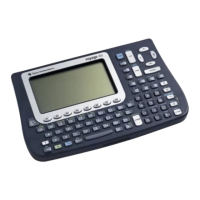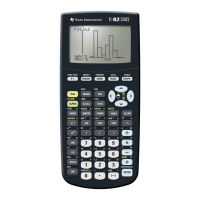! Display the graph screen using trace so that the data points and function can be traced.
Control returns to the program after the user is done viewing the graph. Both the data points and the
function can be traced, as usual, with the [UP], [DOWN], [LEFT] and [RIGHT] cursor movement keys.
The user must press [ENTER] or [ESC] to continue running the program. You might consider
displaying a dialog box with this information before showing the graph.
Since newplot() can only use global variables, xlist and ylist are deleted before the program exits.
The function is plotted by building a string, for example
"sin(x)→y1(x)"
then this string is evaluated with expr(). The number of the y-function is passed as the fpn parameter,
so if fpn = 3, then the string is actually
"sin(x)→y3(x)"
The function
string(exact(fpn))
is used to convert fpn to a string which is a simple integer with no decimal points or exponential
notation, regardless of the current display mode settings.
Unfortunately, this program leaves the plot definition behind for xlist and ylist. Since the variables are
deleted, the plot will not display, but an error will occur the next time the graph window is shown,
unless the plot definition is manually deleted. There is no known method to delete the plot definition
within the program.
(Credit to Olivier Miclo)
[4.5] 3D parametric line and surface plots
The 89/92+ do not have built-in functions to plot three dimensional line and surface plots. However,
S.L. Hollis comes to the rescue, with his routines view3d() and parasurf(). You can get them from his
website at http://www.math.armstrong.edu/ti92/.
[4.6] Graphing piece-wise defined functions with "|" operator
This method uses the Y= Editor to define several functions, each of which defines the function over a
given range:
y1 = f1(x) | range1
y2 = f2(x) | range2
y3 = f3(x) | range3
etc...
f1, f2 and f3 are the functions for each range. range1, range2 and range 3 are the conditional
expressions that define the x-range for each function. '|' is the "where" operator. For example:
4 - 6

